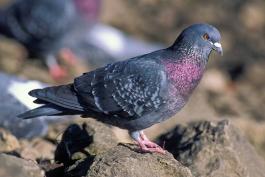
The rock pigeon is familiar to most of us as the common pigeon of city parks, downtown buildings, barns, and cliffs. Many color forms exist, but the wild type has a dark head, breast, and shoulders, a light gray body, two dark bars on the wings, a white rump, and a dark band on the tip of the tail. Other colors range from all white to all black, with rusty colors, spotted, or a combination of colors and patterns. The feet are pink. The song is a soft cooing.
Similar species: The band-tailed pigeon may occur in Missouri as an accidental winter resident from the southwest. It is purplish gray, has a crescent white collar on the back of its neck, and has a lightened, paler gray tail tip. Its bill and feet are yellow. Unlike the rock pigeon, it is native to western North America.
Length: 12½ inches (tip of bill to tip of tail).

Statewide.
Habitat and Conservation
This is the common pigeon of city parks, downtown buildings, barns, and cliffs. Although native to Eurasia, it has been domesticated for over five thousand years, and feral and wild rock pigeons are now found nearly worldwide. This species originated as a cliff nester, and in modern cities large buildings provide a parallel, quite suitable habitat. Pigeons are spectacular navigators, finding their way using the earth’s magnetic fields, the position of the sun, and sounds and smells.
Food
Forages in cities, suburbs, and rural areas for waste grain, insects, some leafy plant material, and miscellaneous foods discarded by humans. Feeding pigeons in parks is a longtime part of urban culture. Because of their potentially large numbers and associated messy droppings, the feeding of pigeons in cities is usually discouraged. Pigeons, like other members of the dove family, can drink water while keeping their bill down; they do not have to tilt their heads back to swallow.
Status
Common permanent resident. This species was introduced in North America in the early 1600s.
Life Cycle
City dwellers and farm families are familiar with the life cycle of pigeons, which build their flimsy twig-and-straw platform nests on window ledges, in bridges, in barns and silos, and other covered, ledgelike structures. Both parents care for the young. Clutches comprise 1-3 eggs, which are incubated for 18 days. The young leave the nest after about a month. There can be up to 6 broods a year. Nests are often reused; they strengthen like pottery as a result of accumulated droppings.
Human Connections
Rock pigeons have been domesticated for thousands of years, and homing and carrier pigeons have helped humans for nearly as long. Some messenger pigeons were awarded medals for bravery after the First and Second World Wars. Other pigeons are bred for fancy plumages, racing, or food (squab).
Ecosystem Connections
Because they live mainly in human-altered settings, where most wild animals can’t survive, they have a surprisingly small influence on natural communities. Many raptors prey on pigeons, and pigeons form a very large part of the diet of urban-dwelling peregrine falcons.








About 350 species of birds are likely to be seen in Missouri, though nearly 400 have been recorded within our borders. Most people know a bird when they see one — it has feathers, wings, and a bill. Birds are warm-blooded, and most species can fly. Many migrate hundreds or thousands of miles. Birds lay hard-shelled eggs (often in a nest), and the parents care for the young. Many communicate with songs and calls.





















